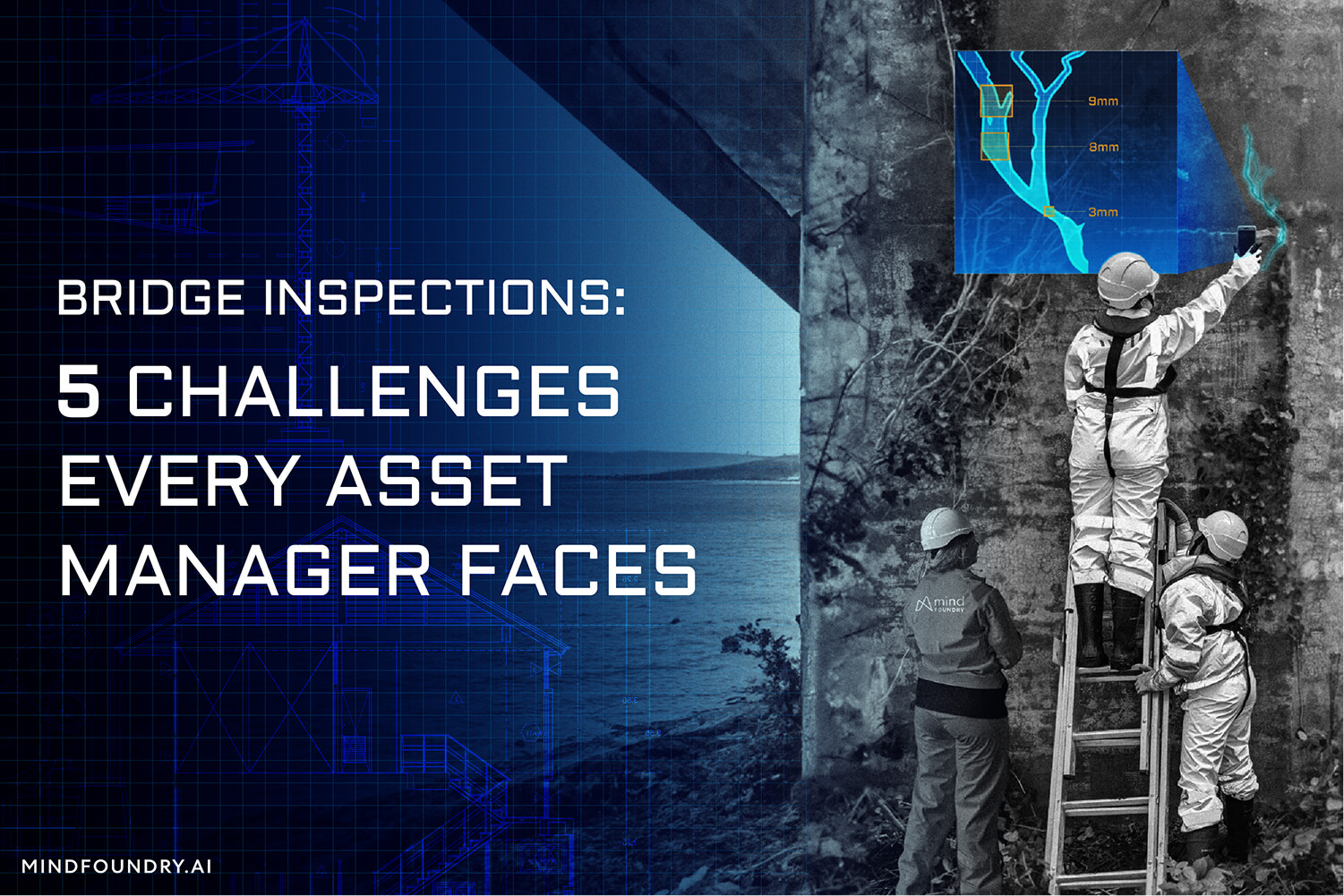AI Assurance Explained: Trust, Safety, and Operational Impact
The UK-USA Technology Prosperity Deal sees overseas organisations pledging £31 billion of investment into UK AI infrastructure. As AI investment...
7 min read
-2.png) Claire Butcher
:
May 9, 2025 1:46:04 PM
Claire Butcher
:
May 9, 2025 1:46:04 PM

Across the UK, there are at least 100,000 bridges, each one requiring ongoing maintenance to remain safe and operational. The decisions that bridge managers make about how to approach this maintenance are underpinned by three fundamental questions:
It is hugely challenging for a bridge manager to answer these questions consistently and defensibly across hundreds or thousands of diverse assets with huge variations in age, needs, and demands. Effective maintenance depends on clearly and completely understanding a bridge’s structural health, and in the UK, inspections are the main tool for gathering this information.
However, the current system has gaps. Limitations in inspection methods have led to a fragmented understanding of bridge health, and today, one in every 25 council-maintained bridges is classified as “substandard.” Nevertheless, there is cause for optimism that this situation can be reversed.
AI and Machine Learning have already proven their ability to process vast amounts of data to enhance decision-making across numerous industries. When applied to bridge inspections, these technologies can give asset managers a more complete picture of current asset conditions, predict future bridge deterioration, and enable faster, more informed maintenance decisions.
Having accurate and up-to-date data on asset condition and performance is the first defence against failure and is essential to making good decisions. To gather this data, inspections are performed on a regular basis.
Most bridges receive a routine inspection every two years to identify obvious defects or signs of deterioration and monitor any changes in their condition over time. Typically, these inspections are carried out in person and are as simple as a ground-level visual appraisal. They gather data in the form of notes and images on the visible elements of the asset and create a report, whilst additional key information, such as a condition score, is used to populate an asset condition database.
UK bridges typically undergo a more detailed and thorough inspection every six years, during which an inspector is within touching distance of each element. These inspections detect hidden defects that routine inspections may be unable to capture, such as corrosion of a difficult-to-view element. They also produce greater quantities of imagery and more detailed notes, which are likely to include sketches of the structure. Like the two-year inspections, the information is compiled into a report, although this report invariably takes longer to produce, and the same key condition information will be input into the asset database.
Further details on a structure can be determined when it is reassessed from a structural perspective, typically every 18 years or whenever an event may cause a loading capacity change. The inspections determine condition data through images, notes, measurements, and detailed sketches. A thorough and detailed report is produced with key information added to the database along with any fundamental changes to the asset, such as an imposed weight restriction.
If no emergency action is required, follow-up inspections or repairs are scheduled depending on the nature and severity of the defects and in line with budgets and service level expectations. This can be routine maintenance, like drainage cleaning or surface repairs, or major repairs and structural strengthening or replacement for bridges in poor condition. The inspection report is also checked against regulations, legal obligations, and safety standards like CS 450—Inspection of Highway Structures and the Network Rail Standards.
An inspection report can range from simple handwritten notes accompanied by photos or videos to more detailed digital records. Compiling, processing, and storing these reports is time-consuming and tedious, especially for more complex inspections. Information is often either not captured in sufficient detail or certain nuances are overlooked between the inspection and reporting.
Bridge engineers, asset managers, and inspectors then analyse this report, assess the findings and classify defects by severity. At each stage, the condition score of key elements is noted, although different asset owners use slightly varying database recording processes and reporting styles. An overall score is assigned to the bridge, indicating its risk of failure from condition deterioration, and any emergency actions are flagged. Data from the individual bridges is then scaled up to create a portfolio.
Making decisions based on this information is inherently challenging, as the collected data is subjective at both the element and asset levels. Also, an asset owner can be responsible for many different types and sub-types of assets, so to input the data into decision support tools, such as Structures Asset Valuation and Investment (SAVI), simplifications are often made to allow portfolio-level decisions.
This means tracing a decision made at a portfolio level to the data gathered at the individual asset level is impossible using the simplified data alone, which makes prioritisation based on severity and likelihood fraught with uncertainty.
Understanding the condition of not just individual bridges but entire networks through inspections faces several significant obstacles.
1. Scale
With around 100,000 bridges across the UK, and routine inspections required every two years in most cases, bridge owners must complete 4,167 monthly inspections to keep pace. Although inspection frequency can vary depending on the bridge’s condition and importance, this highlights the sheer scale of the challenge facing the people responsible for deciding which bridge inspections to prioritise. Most of them simply don’t have the time, resources, or workforce to inspect every single structure adequately using traditional methods.
The vast number of bridges also means that ownership and responsibility can sometimes be unclear, especially for older or rural structures, which adds to the problem. As a result, some bridges may go without inspections for long periods, until serious deterioration, or even failure, forces action. The longer deterioration goes unnoticed, the more expensive the maintenance and repair become, and so, timely interventions are critical for effective bridge management.

The longer deterioration goes unnoticed, the more expensive the maintenance and repair become.
2. Cost
Bridge inspections aren’t free. A routine inspection might cost a few hundred pounds, but specialised inspections, such as those on post–tensioned structures, can exceed £100,000. Also, initial bridge inspections often don’t capture the necessary data to make an effective decision on maintenance or repairs, so a re-inspection must be scheduled and paid for to correct this shortcoming.
However, the costs don’t stop there. Every closure, detour, and disruption caused by an inspection brings additional expenses, putting even greater strain on already overstretched budgets. These financial pressures make it even more essential for bridge owners to ensure that each inspection gives them the quality data they need to make informed, cost-effective decisions.
3. Resource Constraints
Government budgets set the limits for the authorities responsible for managing the UK’s bridges. In today’s economic climate, the pressure to cut costs and reduce waste is greater than ever, placing increasing importance on bridge owners to optimise their budgets.
Meanwhile, the scale of the challenge continues to grow. It’s estimated that clearing the backlog of maintenance work on the UK’s road bridges alone would cost £6.8 billion. The number for the UK’s roads is even more alarming, with a staggering £17 billion needed to address the repair backlog. Despite this, the Autumn 2024 Budget allocated just £1.6 billion in capital funding for local highways maintenance in England, a fraction of what is needed.
With funding falling so far short of demand, it’s impossible to repair all the bridges simultaneously, and justifying funding becomes pivotal. Bridge managers are forced to make tough choices, prioritising inspections and repairs to stretch limited budgets as far as possible without compromising structural security and public safety. Current inspection methods also don’t give bridge owners sufficient understanding of overall portfolio health to justify requests for more budget.
4. Disruption
Many inspections require partial or full closures to ensure the safety of workers and the public. These closures can cause significant disruption to local communities, impacting businesses, commuters, and daily life. This adds to the importance of performing them quickly and efficiently and ensuring the data gathered is meaningful for decision-making.
As well as inconvenience, the inspections themselves can pose safety risks, especially when they involve complex logistics, challenging environments, or difficult access. Managing these risks while minimising disruption adds yet another layer of difficulty for bridge owners and inspection teams.
5. Data
One of the biggest challenges with current bridge inspection methods is the variable quality of the data capture. Unstructured notes or blurred images do not scale across inspections to determine what changes over time. Human subjectivity can also undermine them, as two inspectors may inspect the same bridge on different occasions and have slightly differing opinions on a defect or the structure’s overall health, sometimes resulting in what appears to be a miraculous “self-healing”. This can lead to inconsistent reports and a fragmented, inaccurate understanding of bridge conditions.
Photographing defects can remove some of this subjectivity and inconsistency, but these images can be too dark, blurry, or poorly framed to identify and assess defects accurately. This means that bridges may need re-inspections, adding yet more costs and causing further unnecessary disruption. Either that, or the asset owner must simply “make do” with the increased condition uncertainty.
It can also be hard to tell from a photo where the defect is located on the bridge, making it challenging to prioritise a bridge’s maintenance effectively. Visually appraising a defect and comparing how it has changed from memory or vastly different photo angles is also hugely challenging, but assessing change over time is essential for bridge owners to understand a bridge’s rate of deterioration and identify how rapidly an intervention is needed.
Even when inspections are completed, the resulting data is typically stored in basic, inconsistent formats. This makes it difficult for asset managers to access historical reports or track how a bridge’s condition changes over time, an essential part of effective maintenance planning.
What does this mean in practice? It means that bridge owners are trying to prioritise inspections with only a partial understanding of which structures actually need them. As a result, some bridges are inspected ahead of others that need attention more urgently, while other bridges deteriorate unnoticed until serious, and far more expensive, problems emerge.
Even when inspections are done, critical information is often not captured, captured inconsistently or with different data formats, or lost in outdated systems that make retrieval and comparison problematic. To avoid slipping further into an era of crumbling infrastructure, we must rethink bridge inspections: combining human expertise with advanced AI and Machine Learning to capture better data, make smarter decisions, and protect these vital assets for the future.
Asset managers need to conduct bridge inspections that capture high-quality data in a standardised format, enabling them to understand the overall condition of all their bridges. In so doing, they can lay the foundation for a swathe of new AI capabilities to ensure our bridges don’t deteriorate unnoticed but remain safe, stable, and resilient as the world changes around them.
This is why we developed Windward Inspect: A mobile-first inspection tool built to bring the power of AI into the hands of bridge inspectors.
Windward Inspect uses advanced computer vision, combined with intuitive, consistent workflows, to bring simplicity to a complex process. We turn routine inspections into a source of high-quality, standardised data. This enables asset managers to see the true condition of their entire portfolio, make evidence-based, defensible funding requests and unlock the predictive capabilities of Digital Custodianship, all without disrupting established workflows.
With Windward Inspect, you can analyse and understand how a defect has changed over time.
Ready to modernise your bridge inspections? Discover Windward Inspect.

The UK-USA Technology Prosperity Deal sees overseas organisations pledging £31 billion of investment into UK AI infrastructure. As AI investment...

Industrial AI is increasingly coming to the fore in physical industries, but achieving measurable real-world impact requires careful consideration...

Of all the technologies being explored today, Quantum technologies are some of the most exciting and potentially most revolutionary, and the UK is at...